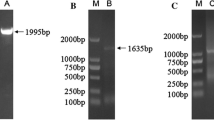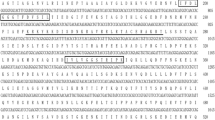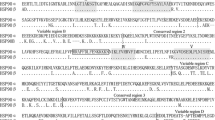Abstract
Heat shock protein 90 (HSP90) is a highly conserved molecular chaperone important in the maturation of a broad spectrum of proteins. In order to evaluate the effect of copper (Cu2+) and cadmium (Cd2+) on the expression of HSP90 from Tanichthys albonubes (designated TaHSP90), the full-length complementary DNA (cDNA) of TaHSP90 was cloned using reverse transcription PCR and rapid amplification of cDNA ends (RACE) techniques. A 2,687-bp sequence was sequenced and consisted of an open reading frame (ORF) of 2,181 bp encoding a polypeptide of 727 amino acids with five HSP90 family signatures. Homologous analysis revealed that TaHSP90 gene shared high similarity with other known HSP90 genes and belonged to HSP90β subtype. Fluorescent real-time quantitative PCR was used to examine the expression pattern of TaHSP90β mRNA in different tissues (liver, muscle, gill, fin, eye, ovary, intestine and brain), and the result indicated that TaHSP90β was widely expressed in all examined tissues at different levels. Sensitivity of TaHSP90β to copper and cadmium was examined by exposing fish to different concentrations of Cu2+ (0, 13.50 and 27.00 μg/L) and Cd2+ (0, 1.15, 2.31 mg/L) for 24, 48, 72 and 96 h, respectively. The copper treatment induced TaHSP90β expression slight increase only at 24 and 48 h, while cadmium treatment caused slight down-regulation of TaHSP90β only 72 and 96 h. Our data suggest that the cloning and expression analysis of T. albonubes HSP90β gene provided useful molecular information of T. albonubes responses in stress conditions and potential ways to monitor the chronic stressors in T. albonubes culture environments.




Similar content being viewed by others
References
Ali A, Krone PH, Pearson DS, Heikkila JJ (1996) Evaluation of stress-inducible hsp90 gene expression as a potential molecular biomarker in Xenopus laevis. Cell Stress Chaperon 1:62–69
Ali KS, Ágnes F, Nemcsók J, Edit H (2010) Expression of heat shock and metallothionein genes in the heart of common carp (Cyprinus carpio): Effects of temperature shock and heavy metal exposure. Acta Biol Hung 61:10–23
Andrew AS, Warren AJ, Barchowsky A, Temple KA, Klei L, Soucy NV, O’Hara KA, Hamilton JW (2003) Genomic and proteomic profiling of responses to toxic metals in human lung cells. Environ Health Perspect 111:825–838
Baatrup E (1991) Structural and functional effects of heavy metals on the nervous system, including sense organs, of fish. Comp Biochem Physiol C 100:253–257
Basu N, Todgham AE, Ackerman PA, Bibeaub MR, Nakanoa K, Schulteb PM, Iwama GK (2002) Heat shock protein genes and their functional significance in fish. Gene 295:173–183
Brown MA, Zhu L, Schmidt C, Tucker PW (2007) Hsp90-from signal transduction to cell transformation. Biochem Biophys Res Commun 363:241–246
Cara JB, Aluru N, Moyano FJ, Vijayan MM (2005) Food-deprivation induces HSP70 and HSP90 protein expression in larval gilthead sea bream and rainbow trout. Comp Biochem Physiol B 142:426–431
Chan BPL, Chen X (2009) Discovery of Tanichthys albonubes Lin 1932 (Cyprinidae) on Hainan Island, and notes on its ecology. Zool Res 30:209–214 (in Chinese)
Chen F, Zhou QX (2009) Joint toxic effects of galaxolide and cadmium on Carassius auratus under polluting flow conditions containing soil-water interfaces from urban areas. J Zhejiang Univ Sci 35:228–236 (in Chinese)
Chen B, Zhong D, Monteiro A (2006) Comparative genomics and evolution of the HSP90 family of genes across all kingdoms of organisms. BMC Genomics 7:156
Csermely P, Schnaider T, Soti C, Prohászka Z, Nardai G (1998) The 90-kDa molecular chaperone family: structure, function and clinical applications. A comprehensive review. Pharmacol Ther 79:129–168
David HE, Dawe AS, Pomeral DID, Jones D, Candido EPM, Daniells C (2003) Construction and evaluation of a transgenic hsp16-GFP-lacZ Caenorhabditis elegans strain for environmental monitoring. Environ Toxicol Chem 22:111–118
Dundjerski J, Kovač T, Pavković N, Čvoro A, Matić G (2000) Glucocorticoid receptor-Hsp90 interaction in the liver cytosol of cadmium-intoxicated rats. Cell Biol Toxicol 16:375–383
Feder ME, Hofmann GE (1999) Heat-shock proteins, molecular chaperones, and the stress response: evolutionary and ecological physiology. Annu Rev Physiol 61:243–282
Flemming CA, Trevors JT (1989) Copper toxicity and chemistry in the environment: a review. Water Air Soil Pollut 44:143–158
Gao Q, Song LS, Ni DJ, Wu LT, Zhang H, Chang YQ (2007) cDNA cloning and mRNA expression of heat shock protein 90 gene in the haemocytes of Zhikong scallop Chlamys farreri. Comp Biochem Physiol B 147:704–715
Gibbs AG, Perkins MC, Markow TA (2003) No place to hide: microclimates of Sonoran Desert Drosopbila. J Thermal Biol l28:353–362
Gophna U, Ron EZ (2003) Virulence and the heat shock response. Int J Med Microbiol 292:453–461
Gupta RS (1995) Phylogenetic analysis of the 90 kD heat shock family of protein sequences and an examination of the relationship among animals, plants, and fungi species. Mol Biol Evol 12:1063–1073
Hartl FU, Hayer-Hart M (2002) Molecular chaperones in the cytosol: from nascent chain to folded protein. Science 295:1852–1858
Heikkila JJ (2010) Heat shock protein gene expression and function in amphibian model systems. Comp Biochem Physiol A 156:19–33
Hermesz E, Abraham M, Nemcsok J (2001) Identification of two hsp90 genes in carp. Comp Biochem Physiol C 129:397–407
Iwama GK (2006) Stress in fish. Ann NY Acad Sci 851:304–310
Iwama GK, Thomas PT, Forsyth RB, Vijayan MM (1998) Heat shock protein expression in fish. Rev Fish Biol Fish 8:35–56
Jarup L (2003) Hazards of heavy metal contamination. Br Med Bull 68:167–182
Krone PH, Sass JB (1994) HSP 90 alpha and HSP 90 beta genes are present in the zebrafish and are differentially regulated in developing embryos. Biochem Biophys Res Commun 204:746–752
Lees-Miller SP, Anderson CW (1989) The human double-stranded DNA activated protein kinase phosphorylates the 90-kDa heat-shock protein, hsp90 alpha at teo NH2-terminal threonine residues. J Biol Chem 264:17275–17280
Liang XF, Chen GZ, Chen XL, Yue PQ (2008) Threatened fishes of the world: Tanichthys albonubes Lin 1932 (Cyprinidae). Environ Biol Fish 82:177–178
Livak KJ, Schmittgen TD (2001) Analysis of relative gene expression data using real-time quantitative PCR and the 2(−Delta Delta C (T)) method. Method 25:402–408
Luan W, Li FH, Zhang JQ, Wen R, Li YT, Xiang JH (2010) Identification of a novel inducible cytosolic Hsp70 gene in Chinese shrimp Fenneropenaeus chinensis and comparison of its expression with the cognate Hsc70 under different stresses. Cell Stress Chaperon 15:83–93
Manchado M, Salas-Leiton E, Infante C, Poncea M, Asensioa E, Crespoa A, Zuastia E, Cañavatea JP (2008) Molecular characterization, gene expression and transcriptional regulation of cytosolic HSP90 genes in the flatfish Senegalese sole (Solea senegalensis Kaup). Gene 416:77–84
Moore SK, Kozak C, Robinson EA, Ullrich SJ, Appella E (1987) Murine 86- and 84-kDa heat shock proteins, cDNA sequences, chromosome assignments, and evolutionary origins. J Biol Chem 264:5343–5351
Nadeau D, Corneau S, Plante I, Morrow G, Tanguay RM (2001) Evolution for Hsp70 as a biomarker of effect of pollutions on the earthworm Lumbricus terrestris. Cell Stress Chaperon 6:153–163
Palmisano AN, Winton JR, Dickhoff WW (2000) Tissue-specific induction of Hsp90 mRNA and plasma cortisol response in chinook salmon following heat shock, seawater challenge, and handling challenge. Mar Biotechnol 2:329–338
Pan F, Zarate JM, Tremblay GC, Bradley TM (2000) Cloning and characterization of salmon hsp90 cDNA: upregulation by thermal and hyperosmotic stress. J Exp Zool 287:199–212
Papaconstantinou AD, Brown KM, Noren BT (2003) Mercury, cadmium, and arsenite enhance heat shock proteinsynthesis in chick embryos prior to embryotoxicity. Birth Defects Res B 68:456–464
Peakall DB, Walker CH (1994) The role of biomarkers in environmental assessment (3). Vertebrates. Ecotoxicology 3:173–179
Pearl LH, Prodromou C (2000) Structure and in vivo function of Hsp90. Curr Opin Struct Biol 10:46–51
Pearl LH, Prodromou C (2001) Structure, function and mechanism of the Hsp90 molecular chaperone. Adv Protein Chem 59:157–186
Pearl LH, Prodromou C (2006) Structure and mechanism of the Hsp90 molecular chaperone machinery. Annu Rev Biochem 75:271–294
Picard D (2006) Chaperoning steroid hormone action. Trends Endocrinol Metab 17:229–235
Pratt WB, Toft DO (1997) Steroid receptor interactions with heat shock protein and immunophilin chaperones. Endoer Rev 18:306–360
Prodromou C, Pearl LH (2003) Structure and functional relationships of Hsp90. Curr Cancer Drug Targets 3:301–323
Ryan JA, Hightower LE (1996) Stress proteins as molecular biomarkers for environmental toxicology. Stress-inducible cellular responses. Birkhäuser Verlag, Basel, pp 411–424
Sass JB, Weinberg ES, Krone PH (1996) Specific localization of zebrafish hsp90α mRNA to myoDexpressing cells suggests a role for Hsp90α during normal muscle development. Mech Dev 54:195–204
Silke K, Bernd F (2003) Polychlorinated biphenyls affect gene expression in the rabbit preimplantation embryo. Mol Reprod Dev 64:251–260
Somji S, Ann Sens M, Garrett SH, Gurel V, Todd JH, Sens DA (2002) Expression of hsp90 in the human kidney and proximal tubule cells exposed to heat, sodium arsenite and cadmium chloride. Toxicol Lett 133:241–254
Sonoda S, Fukumoto K, Izumi Y, Yoshida H, Tsumuki H (2006) Cloning of heat shock protein genes (hsp90 and hsc70) and their expression furing larval diapause and cold tolerance acquisition in the rice stem borer, Chilo suppressalis Walker. Arch Insect Biochem Physiol 63:36–47
Sreedhar AS, Kalmár, Csermely P, Shen YF (2004) HSP90 isoforms: functions, expression and clinical importance. FEBS Lett 526:11–15
Stohs SJ, Bagchi D (1995) Oxidative mechanisms in the toxicity of metal ions. Free Radic Biol Med 18:321–336
Tamura K, Dudley J, Nei M, Kumer S (2007) MEGA4: molecular evolutionary genetics analysis (MEGA) software version 4.0. Mol Biol Evol 24:1596–1599
Theodoraki MA, Mintzas AC (2006) cDNA cloning, heat shock regulation and development expression of the hsp83 gene in the Mediterranean fruit fly Ceratitis capitata. Insect Mol Biol 15:839–852
Tom AM, Auslander M (2005) Transcript and protein environmental biomarkers in fish—a review. Chemosphere 59:155–162
Tomanek L, Somero GN (2002) Interspecific-and acclimation-induced variation in levels of heat-shock proteins 70 (hsp70) and 90 (hsp90) and heat-shock transcription factor-1 (HSF1) in congeneric marine snails (genus Tegula): implications for regulation of hsp gene expression. J Exp Biol 205:677–685
Triebskorn R, Köhler H-R, Honnen W, Schramm M, Adams SM, Müller EF (1997) Induction of heat shock proteins, changes in liver ultrastructure, and alterations of fish behavior: are these biomarkers related and are they useful to reflect the state of pollution in the field? J Aquat Ecosyst Stress Recov 6:57–73
Wang R, Ma G, Fang Z (2006) Safety assessment and acute toxicity of copper, cadmium and zinc to white cloud mountain minnow Tanichthys albonubes. Fish Sci 25:117–120 (in Chinese)
Wang R, Chen Y, Xu J, Fang ZQ, Ma GZ (2007) Effects of cypermethrin on superoxide dismutase (SOD) activities in liver and gill tissues of Tanichthys albonubes. Ecol Environ 16:790–793 (in Chinese)
Wang T, Chen S, Meng L, Liu Y (2010) Molecular cloning and expression of heat shock protein 90 gene cDNA from turbot Psetta maximua. Prog Fish Sci 31:51–59 (in Chinese)
Wu JP, Chen HC (2004) Effects of cadmium and zinc on oxygen consumption, ammonium excretion, and osmoregulation of white shrimp (Litopenaeus vannamei). Chemosphere 57:1591–1598
Yang Z, Yao J, Fang Z (2007) Acute toxicity and safety assessment of DDTs to white cloud mountain minnow Tanichthys albonubes larval stages. Lab Anim Comp Med 27:123–126 (in Chinese)
Young JC, Moarefi I, Hartl FU (2001) Hsp90: a specialized but essential protein-folding tool. J Cell Biol 154:267–273
Zhang H, Burrows F (2004) Targeting multiple signal transduction pathways through inhibition of Hsp90. J Mol Med 82:488–499
Acknowledgments
This research was supported by National Major Science and Technology Projects on Management and Control of Water Pollution in China (grants 2008ZX07211-007). We are grateful of Dr. Xichang Tan of Pearl River Research Institute, Chinese Academy of Fisheries Science for his aid in collecting experiment fish. We thank Dr. Laura Tiu of Ohio State University, USA, and Dr. Hongmei Cai of College of Resources and Environment, Huazhong Agricultural University, China, for their valuable language helps in preparing the paper.
Author information
Authors and Affiliations
Corresponding author
Rights and permissions
About this article
Cite this article
Liu, H., Chen, H., Jing, J. et al. Cloning and characterization of the HSP90 beta gene from Tanichthys albonubes Lin (Cyprinidae): effect of copper and cadmium exposure. Fish Physiol Biochem 38, 745–756 (2012). https://doi.org/10.1007/s10695-011-9556-2
Received:
Accepted:
Published:
Issue Date:
DOI: https://doi.org/10.1007/s10695-011-9556-2




